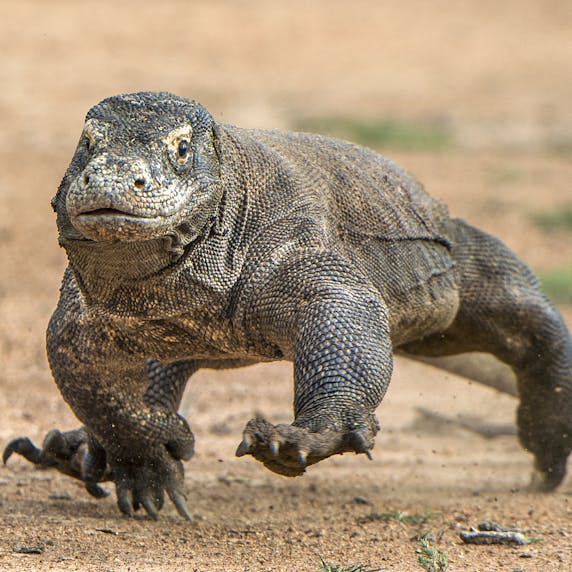
On land, the biggest predator is usually a mammal, such as a bear, tiger or lion. But on a few small islands of Indonesia, a reptile is at the top of the food chain: the Komodo dragon, the largest lizard in the world. But these days, this impressive hunter is often hunted by humans. Climate change and habitat loss also threaten the Komodo dragon. That is why Rotterdam Zoo helps to protect this unique predator.
Varanus komodoensis

Up to 50 years
♀ 1.8 meters
♂ 3 meters
♀ 55 kilograms
♂ 90 kilograms
The Komodo dragon is a large, gray-green monitor lizard. Its legs are at right angles to its body. As a result, the Komodo dragon moves in a kind of "s-shape," putting its left front leg and right hind leg forward at the same time, as if swinging forward. Although the komodo dragon may not look fast, it can run as fast as 20 kilometers per hour. This allows it to quickly emerge from its hiding place to grab prey with its sharp, serrated teeth.
...young Komodo dragons climb trees to avoid being eaten by adult Komodo dragons?
...Komodo dragons smell using their split tongues?
Komodo dragons are found on four small islands in Indonesia: Flores, Rinca, Padar and Komodo, from which the monitor lizards get their name. There they live in mixed landscapes of forests and dry savannas. They are also found in coastal areas with mangrove forests. Young animals stay mostly in forested areas, where they climb trees to hide from predators.

Komodo dragons sometimes hunt large prey, such as deer, boar and buffalo. For this purpose, they possess a deadly weapon: venom glands. When they bite into their prey, this venom flows from the venom glands into the blood of the prey animal. Once envenomed, the prey is slowly weakened and will eventually drop dead. Sometimes the Komodo dragon chases its prey for up to a week before the prey succumbs to the venom. This is followed by a hefty feast: the Komodo dragon can eat as much as 80% of its body weight at a time!

One of the biggest threats to the Komodo dragon is the loss of habitat. For example, local people burn down pieces of savannah to make room for agriculture. In addition, local people hunt the prey animals of the Komodo dragon. In the absence of other food, Komodo dragons attack farmers' livestock. To protect their livestock, farmers kill monitor lizards that come too close. As a result, the number of Komodo dragons in the wild has declined sharply. But due to climate change, habitat appears to be shrinking further: by 2100, 30% of the islands where they occur are at risk of being underwater due to sea level rise.

Rotterdam Zoo supports the Komodo Survival Program (KSP) on the island of Flores. Here, camera traps are placed to count the number of Komodo dragons. If a Komodo dragon passes by, a picture is taken: 2,000 pictures of monitor lizards have already been taken this way! The KSP is also training new rangers to help with the monitoring project. This way they can keep a close eye on whether the number of Komodo dragons is decreasing or increasing.
The Komodo dragons at Rotterdam Zoo are kept at a temperature of 30ºC, about as warm as the area where they naturally occur. The adult animals each have their own enclosure and are only brought together for mating. The young animals are also kept separately from the parents: in fact, Komodo dragons do not do nest care and will even eat young Komodo dragons if given the chance! By taking the eggs away from the mother in time, the young have a chance to grow up and contribute to the survival of the species.

